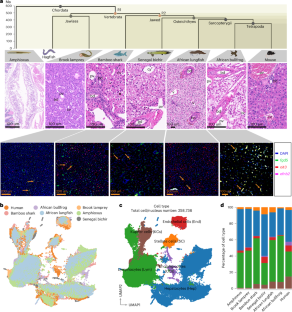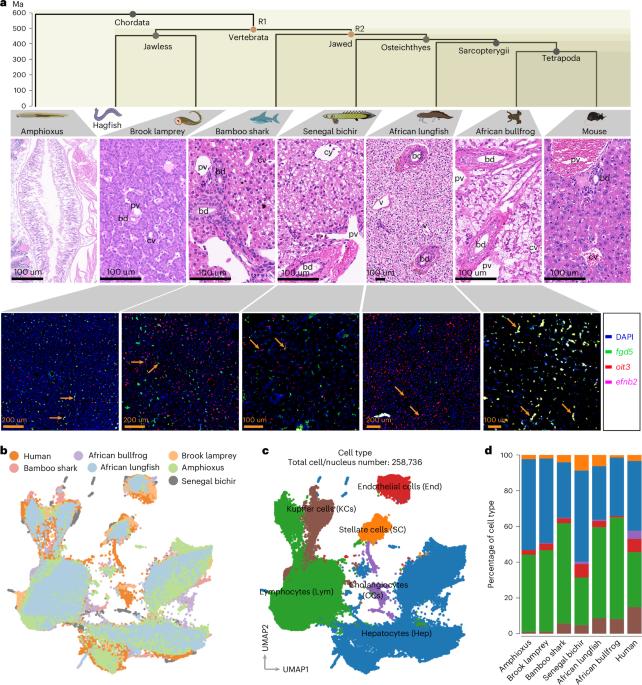文昌鱼肝盲肠和脊椎动物肝脏的单细胞分析揭示了脊椎动物肝脏进化的遗传机制
IF 13.9
1区 生物学
Q1 ECOLOGY
引用次数: 0
摘要
脊椎动物肝脏的进化是复杂器官进化的一个典型例子,但其背后的驱动遗传因素仍然未知。在这里,我们通过比较文昌鱼肝盲肠和脊椎动物肝脏,研究了肝脏的进化遗传学,并考察了脊椎动物内部的功能转变。利用体内和体外实验、单细胞/细胞核RNA-seq数据和基因敲除实验,我们证实文昌鱼肝盲肠和脊椎动物肝脏是同源器官,并表明两轮全基因组复制产生的ohnologues极大地促进了脊椎动物肝脏功能的复杂性。两个ohnologues,即kdr和flt4,在肝窦内皮细胞的发育过程中发挥了重要作用。此外,我们还发现凝血和胆汁生成等与肝脏相关的功能是逐步进化的,其中复制基因发挥了关键作用。我们重建了脊椎动物进化过程中血红素解毒功能从肝脏转移到脾脏的基因足迹。这些发现共同挑战了之前关于器官进化主要由调控元件驱动的假说,强调了基因复制在复杂器官的出现和多样化过程中的重要性。本文章由计算机程序翻译,如有差异,请以英文原文为准。


Single-cell analysis of the amphioxus hepatic caecum and vertebrate liver reveals genetic mechanisms of vertebrate liver evolution
The evolution of the vertebrate liver is a prime example of the evolution of complex organs, yet the driving genetic factors behind it remain unknown. Here we study the evolutionary genetics of liver by comparing the amphioxus hepatic caecum and the vertebrate liver, as well as examining the functional transition within vertebrates. Using in vivo and in vitro experiments, single-cell/nucleus RNA-seq data and gene knockout experiments, we confirm that the amphioxus hepatic caecum and vertebrate liver are homologous organs and show that the emergence of ohnologues from two rounds of whole-genome duplications greatly contributed to the functional complexity of the vertebrate liver. Two ohnologues, kdr and flt4, play an important role in the development of liver sinusoidal endothelial cells. In addition, we found that liver-related functions such as coagulation and bile production evolved in a step-by-step manner, with gene duplicates playing a crucial role. We reconstructed the genetic footprint of the transfer of haem detoxification from the liver to the spleen during vertebrate evolution. Together, these findings challenge the previous hypothesis that organ evolution is primarily driven by regulatory elements, underscoring the importance of gene duplicates in the emergence and diversification of a complex organ. Comparative analysis of single-cell data from the amphioxus hepatic caecum and the liver of several vertebrates shows how genome duplication contributes to cellular diversification and functional complexity of the vertebrate liver.
求助全文
通过发布文献求助,成功后即可免费获取论文全文。
去求助
来源期刊

Nature ecology & evolution
Agricultural and Biological Sciences-Ecology, Evolution, Behavior and Systematics
CiteScore
22.20
自引率
2.40%
发文量
282
期刊介绍:
Nature Ecology & Evolution is interested in the full spectrum of ecological and evolutionary biology, encompassing approaches at the molecular, organismal, population, community and ecosystem levels, as well as relevant parts of the social sciences. Nature Ecology & Evolution provides a place where all researchers and policymakers interested in all aspects of life's diversity can come together to learn about the most accomplished and significant advances in the field and to discuss topical issues. An online-only monthly journal, our broad scope ensures that the research published reaches the widest possible audience of scientists.
 求助内容:
求助内容: 应助结果提醒方式:
应助结果提醒方式:


